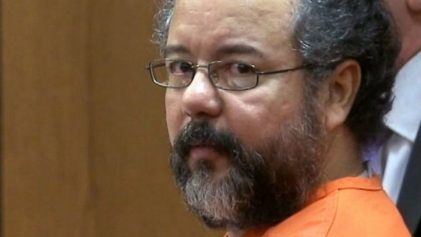Now that the nation has learned the mind-boggling story of the three women held captive for a decade on a normal residential street in Cleveland, a number of questions are being raised.
How did the victims go undetected so long? Did the Cleveland police make mistakes when several neighbors say they called to report suspicious activity coming from the house? Why did police fail to fully investigate and why does the police chief say they didn’t receive the phone calls?
Police are preparing the charges against the three brothers suspected of keeping the three women captive, saying they found chains and ropes used to tie up the victims but no human remains at the house where they were held.
Ariel Castro, 52, who had been fired from his school bus driving job in November for “lack of judgment,” was arrested on Monday right after the women escaped, but his brothers Pedro Castro, 54, and Onil Castro, 50, were taken into custody a short time later.
While several neighbors said they had called police to report suspicious activity at the house where Amanda Berry, Gina DeJesus, Michelle Knight and Berry’s 6-year-old daughter escaped from their captors, police denied those calls from neighbors were made.
“We have no record of those calls coming in over the last ten years,” Cleveland Police Chief Michael McGrath said on Wednesday on NBC’s “Today” show. He squirmed when he was pressed by Savannah Guthrie on whether he was calling the neighbors liars, repeating that there was no record of the calls and he was confident police did not miss opportunities to find the women.
“Absolutely, there’s no question about it,” he said.
McGrath said the women had been allowed outside “very rarely” during their captivity and were in good physical condition, “considering the circumstances.”
“They were released out in the backyard once in a while,” he said.
It was actually the sight of a woman crawling naked in the backyard by a little girl who lived nearby that prompted one of the police calls that McGrath is denying.
Elsie Cintron, who lives three houses away, told CBS News that her daughter once saw a naked woman crawling on her hands and knees in the backyard several years ago and called police. “But they didn’t take it seriously,” Cintron said.
Neighbor Israel Lugo said he called police in November 2011 after his sister saw a girl at the house holding a baby and crying for help, but after police came and banged on the door several times, they left when no one answered, he said.
Lugo also said about eight months ago, his sister saw Ariel Castro park his school bus outside and take a large bag of fast food and several drinks inside.
“My sister said something’s wrong … That’s when my mom called the police,” he said.
Lugo said police came and warned Castro not to park the bus in front of his house.
Neighbor Anthony Westry, said a little girl could often be seen peering from the attic window of the Castro house.
“She was always looking out the window,” he said. Castro would take her to the park to play very early in the morning, “not around the time you would take kids to play,” he said.
But despite all these statements, Cleveland city officials were sticking by their claims that no one called.
Berry, now 27, whose 6-year-old daughter was conceived and born during her captivity, was a prisoner in the house along with DeJesus, 23, who vanished at age 14 in 2004, and Knight, 32, who was 20 when she went missing in 2002.
Cleveland Mayor Frank Johnson said, “We have no indication that any of the neighbors, bystanders, witnesses or anyone else has ever called regarding any information, regarding activity that occurred at that house on Seymour Avenue.”
“We didn’t search hard enough. She was right under our nose the whole time,” said Angel Arroyo, a church pastor who had handed out flyers of DeJesus in the neighborhood.
Even more bizarre, Ariel Castro, who gave children in the largely Puerto Rican neighborhood rides on his motorcycle, even played bass guitar in salsa and merengue bands with Tito DeJesus, an uncle of Gina DeJesus. The uncle said he recalled visiting Castro’s house but never noticing anything out of the ordinary.
In addition, Ariel Castro was friends with the father of Gina DeJesus and helped search for her after she disappeared, according to Khalid Samad, a friend of the family.
“When we went out to look for Gina, he helped pass out fliers,” said Samad, a community activist who was at the hospital with DeJesus and her family on Monday night. “You know, he was friends with the family.”
Neighbor Antony Quiros said he saw Castro comforting Gina DeJesus’ mother at a vigil for her about a year ago. Neighbor Francisco Cruz said he was with Castro the day investigators dug up a yard looking for the girls and Castro told Cruz, “They’re not going to find anyone there,” Cruz recalled.
While the questions spin around the Castro house, neighbor Charles Ramsey, who helped Berry escape, has quickly become an Internet sensation because of the colorful language he has used in describing his role in the saga. But at least one writer, Gene Demby, is asking whether Ramsey’s sudden fame is hiding a condescension.
“Like Ted Williams, the homeless “man with the golden voice,” Antoine Dodson of “Hide Your Kids, Hide Your Wife!” fame, and Sweet Brown of “Oh, Lordy, there’s a fire!” — three other poor black folks who became unlikely Internet celebrities in recent years — Ramsey seemed at ease in front of the camera. And of course, he’s already been Auto-Tuned,” Demby wrote for NPR.
“But race and class seemed to be central to the celebrity of all these people,” he wrote. “They were poor. They were black. Their hair was kind of a mess. And they were unashamed. That’s still weird and chuckle-worthy…Dodson and Brown and Ramsey are all up in our GIFs and all over the blogosphere because they’re not the type of people we’re used to seeing or hearing on our TVs. They’re actually not the type of people we’re used to seeing or hearing at all, which might explain why we get so silly when they make one of their infrequent forays into our national consciousness.”


